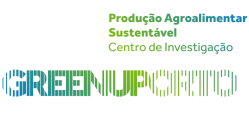Impacto de diferentes técnicas de processamento na cor, matéria seca e atividade da água de larvas de Tenebrio molitor
Resumo
Os insetos comestíveis são uma nova alternativa alimentar, apresentando-se como uma excelente fonte proteica, com grande sustentabilidade ambiental. É vital otimizar as técnicas de processamento de insetos por forma a garantir as melhores condições para a sua utilização como ingrediente alimentar. Neste trabalho, procurou-se compreender os efeitos de diferentes métodos de branqueamento e secagem e a aplicação de ácido ascórbico na cor, teor de matéria seca e atividade da água de larvas Tenebrio molitor. Os resultados obtidos permitiram observar que as condições de branqueamento, nomeadamente a 100ºC, resultaram num menor teor de matéria seca e numa melhor manutenção da cor ao longo do tempo. A aplicação de ácido ascórbico revelou-se inconstante e com efeitos reduzidos na cor das larvas, quer após branqueamento como após secagem. Todas as condições de secagem (forno, micro-ondas e desidratador) resultaram em elevados teores de matéria seca. No entanto, a utilização do micro-ondas permitiu obter os melhores resultados a nível de cor. Assim, estes métodos convencionais podem ser aplicados no processamento de larvas, garantindo a sua segurança alimentar a um custo mais reduzido que a utilização do liofilizador.
Referências
Azzollini D, Derossi A, Severini C (2016). Understanding the drying kinetic and hygroscopic behaviour of larvae of yellow mealworm (Tenebrio molitor) and the effects on their quality. Journal of Insects as Food and Feed 2: 233-243.
Ben Jebli M, Ben Youssef S (2017). The role of renewable energy and agriculture in reducing CO2 emissions: Evidence for North Africa countries. Ecological Indicators 74: 295-301.
Cunha LM, Ribeiro JC (2019). Sensory and Consumer Perspectives on Edible Insects. In: Edible Insects in the Food Sector, Springer, pp. 57-71.
Evans J, Alemu MH, Flore R, Frøst MB, Halloran A, Jensen AB, Maciel-Vergara G, Meyer-Rochow V, Münke-Svendsen C, Olsen SB (2015). ‘Entomophagy’: an evolving terminology in need of review. Journal of Insects as Food and Feed 1: 293-305.
FAO (2009). How to Feed the World in 2050.
FAO, IFAD, UNICEF, WFP, WHO (2019). The State of Food Security and Nutrition in the World 2019. Safeguarding against economic slowdowns and downturns. Rome, FAO.
Heidari-Parsa S (2018). Determination of yellow mealworm (Tenebrio molitor) nutritional value as an animal and human food supplementation. Arthropods 7: 94.
Hill J, McSweeney C, Wright A-DG, Bishop-Hurley G, Kalantar-zadeh K (2016). Measuring Methane Production from Ruminants. Trends in Biotechnology 34: 26-35.
Huang C, Feng W, Xiong J, Wang T, Wang W, Wang C, Yang F (2019). Impact of drying method on the nutritional value of the edible insect protein from black soldier fly (Hermetia illucens L.) larvae: amino acid composition, nutritional value evaluation, in vitro digestibility, and thermal properties. European Food Research and Technology 245: 11-21.
Kröncke N, Böschen V, Woyzichovski J, Demtröder S, Benning R (2018). Comparison of suitable drying processes for mealworms (Tenebrio molitor). Innovative Food Science & Emerging Technologies 50: 20-25.
Kröncke N, Grebenteuch S, Keil C, Demtröder S, Kroh L, Thünemann AF, Benning R, Haase H (2019). Effect of Different Drying Methods on Nutrient Quality of the Yellow Mealworm (Tenebrio molitor L.). Insects 10: 84.
La Barbera F, Verneau F, Amato M, Grunert K (2018). Understanding Westerners’ disgust for the eating of insects: The role of food neophobia and implicit associations. Food Quality and Preference 64: 120-125.
Lenaerts S, Van Der Borght M, Callens A, Van Campenhout L (2018). Suitability of microwave drying for mealworms (Tenebrio molitor) as alternative to freeze drying: Impact on nutritional quality and colour. Food Chemistry 254: 129-136.
Mancini S, Fratini F, Tuccinardi T, Turchi B, Nuvoloni R, Paci G (2019). Effects of different blanching treatments on microbiological profile and quality of the mealworm (Tenebrio molitor). Journal of Insects as Food and Feed 5: 225-234.
Mason JB, Black R, Booth SL, Brentano A, Broadbent B, Connolly P, Finley J, Goldin J, Griffin T, Hagen K, Lesnik J, Lewis G, Pan Z, Ramos JM, Ranalli M, Rojas G, Shockley M, Stull VJ, Swietlik D (2018). Fostering Strategies to Expand the Consumption of Edible Insects: The Value of a Tripartite Coalition between Academia, Industry, and Government. Curr Dev Nutr 2: nzy056.
Melgar-Lalanne G, Hernández-Álvarez A-J, Salinas-Castro A (2019). Edible Insects Processing: Traditional and Innovative Technologies. Comprehensive Reviews in Food Science and Food Safety 18: 1166-1191.
Mishyna M, Chen J, Benjamin O (2020). Sensory attributes of edible insects and insect-based foods–Future outlooks for enhancing consumer appeal. 95: 141-148.
Purschke B, Brüggen H, Scheibelberger R, Jäger H (2018). Effect of pre-treatment and drying method on physico-chemical properties and dry fractionation behaviour of mealworm larvae (Tenebrio molitor L.). European Food Research and Technology 244: 269-280.
Ritchie H, Roser M (2020). Environmental impacts of food production. Our World in Data
Rocha C, Ribeiro JC, Costa Lima R, Prista C, Raymundo A, Vaz Patto MC, Cunha LM (2021). Application of the CATA methodology with children: Qualitative approach on ballot development and product characterization of innovative products. Food Quality and Preference 88: 104083.
Rumpold BA, Schlüter OK (2013). Nutritional composition and safety aspects of edible insects. Molecular nutrition & food research 57: 802-823.
Schouteten JJ, De Steur H, Lagast S, De Pelsmaeker S, Gellynck X (2017). Emotional and sensory profiling by children and teenagers: A case study of the check-all-that-apply method on biscuits. Journal of Sensory Studies 32: e12249.
United Nations DoEaSA, Population Division (2019). World population prospects 2019: Highlights. New York (US): United Nations Department for Economic and Social Affairs
van Huis A, van Itterbeeck J, Klunder H, Mertens E, Halloran A, Muir G, Vantomme P (2013). Edible insects: future prospects for food and feed security. Food and Agriculture Organization of the United Nations.
van Huis A (2016). Edible insects are the future? Proceedings of the Nutrition Society 75: 294-305.
Vandeweyer D, Lenaerts S, Callens A, Van Campenhout L (2017). Effect of blanching followed by refrigerated storage or industrial microwave drying on the microbial load of yellow mealworm larvae (Tenebrio molitor). Food Control 71: 311-314.
Wilkinson J (2012). Methane production by ruminants. UK Vet Livestock 17: 33-35.
Yohannes H (2016). A review on relationship between climate change and agriculture. J Earth Sci Clim Change
Direitos de Autor (c) 2021 Carla Santos, José Carlos Ribeiro, Luís Miguel Cunha

Este trabalho está licenciado com uma Licença Creative Commons - Atribuição 4.0 Internacional.







